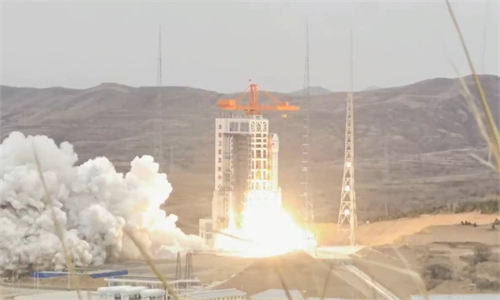
Photo: Wang Jiangbo
China's solid propellant rocket Long March-11 sent three satellites into preset orbits on Wednesday, marking the rocket model's 12th consecutive successful launch in its 12 orbital flights.
The Long March-11, designed and developed by the China Academy of Launch Vehicle Technology (CALT), the country's largest rocket contractor and manufacturer, took off from the Jiuquan Satellite Launch Center around 10:30 am Wednesday. The rocket has pulled off a total of 12 launch missions to date, including two from the sea.
The first sea-based launch was done in June 2019, also using a Long March-11 carrier rocket, on a large semi-submersible barge named Tairui in the Yellow Sea. It marked a breakthrough in the safety, stability and reliability of launches at sea despite complicated marine environments.
The second seaborne launch took place in September 2020, using the Long March-11.
The Wednesday mission was the first solid rocket launch for China in 2022, and according to the rocket developers, the model is expected to take more flights later this year, including some launch-from-sea missions.
It is worth noting that the Long March-11 Y10 launched on Wednesday was the first of its kind assembled at the Haiyang Oriental Aerospace Port in Haiyang, East China's Shandong Province.
The base is part of a comprehensive aerospace project. With an investment of 23 billion yuan ($3.5 billion) and a planned area of 1,860 hectares, the project includes an aerospace industrial park, a port for seaborne rocket launches, and an aerospace-themed tourist park.
The Global Times has learned from Haiyang that the new facility is capable of manufacturing 10 solid rockets a year, with construction underway to double that number.
Apart from the Long March-11 rocket, Smart Dragon-3, a new rocket model that is expected to take its maiden flight in 2022, will also be assembled at the Haiyang assembly base.
The satellites launched on Wednesday are the Tianping-2 A, B, C, which will provide services including atmosphere space environmental measurement and orbit forecast and model corrections, the satellites' developer the state-owned aerospace giant China Aerospace Science & Industry Corporation (CASIC), told the Global Times on Wednesday.



